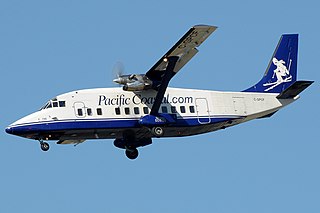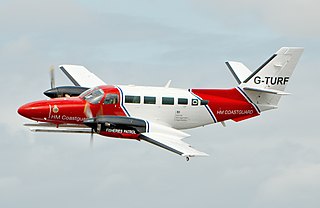
A turboprop is a gas turbine engine that drives an aircraft propeller.

The Cessna 208 Caravan is a utility aircraft produced by Cessna. The project was commenced on November 20, 1981, and the prototype first flew on December 9, 1982. The production model was certified by the FAA in October 1984 and its Cargomaster freighter variant was developed for FedEx. The 4 ft (1.2 m) longer 208B Super Cargomaster first flew in 1986 and was developed into the passenger 208B Grand Caravan.

The Pratt & Whitney Canada PT6 is a turboprop aircraft engine produced by Pratt & Whitney Canada. Its design was started in 1958, it first ran in February 1960, first flew on 30 May 1961, entered service in 1964, and has been continuously updated since. The PT6 consists of two basic sections: a gas generator with accessory gearbox, and a free-power turbine with reduction gearbox. In aircraft, the engine is often mounted "backwards," with the intake at the rear and the exhaust at the front, so that the turbine is directly connected to the propeller. Many variants of the PT6 have been produced, not only as turboprops but also as turboshaft engines for helicopters, land vehicles, hovercraft, and boats; as auxiliary power units; and for industrial uses. By November 2015, 51,000 had been produced, which had logged 400 million flight hours from 1963 to 2016. It is known for its reliability, with an in-flight shutdown rate of 1 per 651,126 hours in 2016. The PT6A turboprop engine covers the power range between 580 and 1,940 shp, while the PT6B/C are turboshaft variants for helicopters.

The de Havilland Canada DHC-3 Otter is a single-engined, high-wing, propeller-driven, short take-off and landing (STOL) aircraft developed by de Havilland Canada. It was conceived to be capable of performing the same roles as the earlier and highly successful Beaver, including as a bush plane, but is overall a larger aircraft.
Empire Airlines is a cargo and former passenger airline based in Hayden, Idaho, near Coeur d'Alene. It operates over 120 scheduled cargo flights a day in 18 US states and Canada. Empire also operated passenger service within Hawaii, under the name "Ohana by Hawaiian", between 2014 and 2021 in partnership with Hawaiian Airlines. Its main base is Coeur d'Alene Airport with a hub at Spokane International Airport. The company slogan is We Can Do That.

The Harbin Y-12 is a high wing twin-engine turboprop utility aircraft built by Harbin Aircraft Industry Group (HAIG). It is the first Chinese-designed and produced aircraft to receive type certificate from the FAA in March 1995.

The Piper M-Class is a family of American light aircraft manufactured by Piper Aircraft of Vero Beach, Florida. The aircraft are powered by single engines and have six seats. Twentieth century production of the class was all piston engined, but turboprop versions called the M500, M600 and M700 (Fury) are now also available.

Austin Airways was a passenger airline and freight carrier based in Timmins, Ontario, and one of the oldest in Canada.

The Embraer EMB 110 Bandeirante is a Brazilian twin-turboprop light transport aircraft designed by Embraer for military and civil use.

The Beechcraft 1900 is a U.S made twin-engine turboprop regional airliner manufactured by Beechcraft. It is also used as a freight aircraft and corporate transport, and by several governmental and military organizations. With customers favoring larger regional jets, then-owner Raytheon ended production in October 2002.
Baron Aviation Services is an American cargo airline based in Vichy, Missouri, United States. It was established in 1973 and operates small package express cargo services on behalf of FedEx Express. Its main base is Rolla National Airport, Vichy, Missouri.

The Short 360 is a commuter aircraft that was built by UK manufacturer Short Brothers during the 1980s. The Short 360 seats up to 39 passengers and was introduced into service in November 1982. It is a larger version of the Short 330.

The Beechcraft Model 99 is a civilian aircraft produced by Beechcraft. It is also known as the Beech 99 Airliner and the Commuter 99. The 99 is a twin-engine, unpressurized, 15 to 17 passenger seat turboprop aircraft, derived from the earlier Beechcraft King Air and Queen Air. It uses the wings of the Queen Air, the engines and nacelles of the King Air, and sub-systems from both, with a specifically designed nose structure.

The Reims-Cessna F406 Caravan II is a turboprop twin engine utility aircraft manufactured and designed by Reims Aviation in cooperation with Cessna.

Maun Airport is an international airport serving the town of Maun in the North-West District of Botswana. It is on the north side of the town and is accessible by shuttle bus or taxi.

Mack Air is a charter airline based in Maun, Botswana. The company has been operating in northern Botswana since 1994.

The Cessna 500 Citation I is a small business jet produced by Cessna, the basis of the Citation family. The Fanjet 500 prototype was announced in October 1968, first flew on September 15, 1969, and was certified as the 500 Citation on September 9, 1971. It was upgraded in 1976 as the Citation I, and the 501 Citation I/SP single-pilot variant was introduced in 1977. Production ended in 1985 with 689 of all variants produced. The straight wing jet is powered by JT15D turbofans. The aircraft was developed into the Citation II.
PT ASI Pudjiastuti Aviation, operating as Susi Air, is a scheduled and charter airline based in Pangandaran, West Java, Indonesia. Sixty percent of the airline's operation serves commercial regular routes and pioneer routes while the rest is charter flights. The company currently operates from several main bases across the Indonesian archipelago. Susi Air is listed in category 2 by Indonesian Civil Aviation Authority for airline safety quality.
CemAir (Pty) South Africa, servicing popular tourist destinations and important business towns, as well as leasing aircraft to other airlines across Africa. The airline's head office and engineering and maintenance facility are located in Hangar 6 OR Tambo International Airport in Johannesburg.

Grand Canyon Scenic Airlines is an American regional airline based in Paradise, Nevada, United States. It operates sightseeing flights from Boulder City Municipal Airport in Boulder City, Nevada. Scenic has been owned by Grand Canyon Airlines since 2008.
















